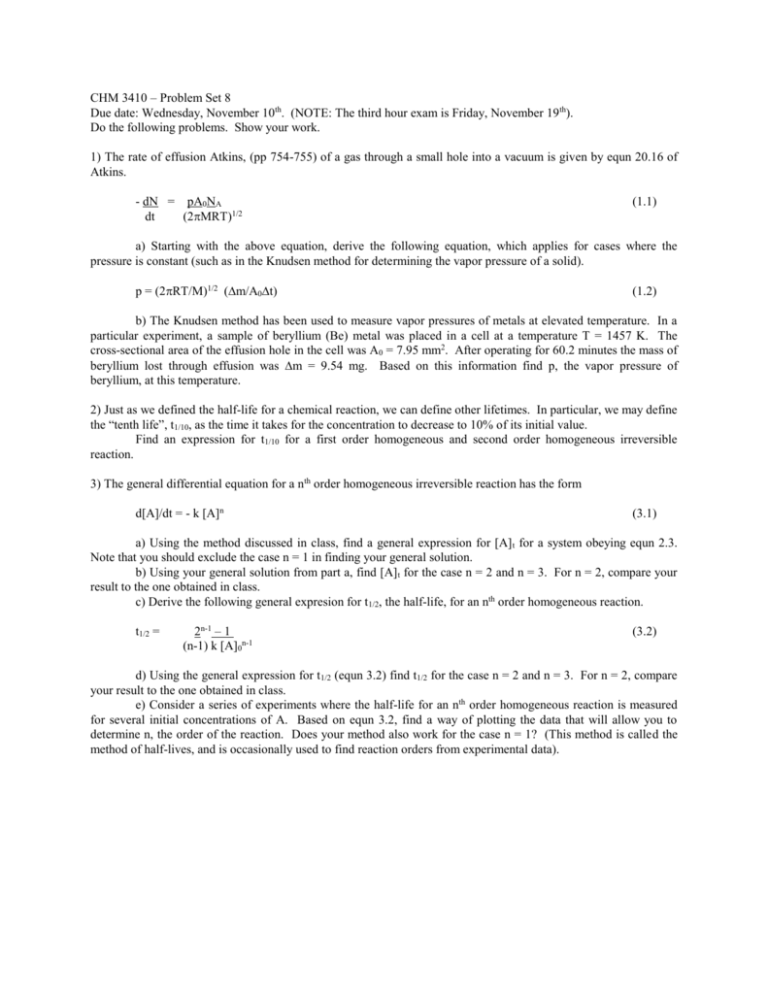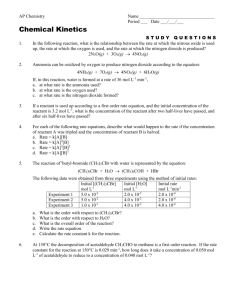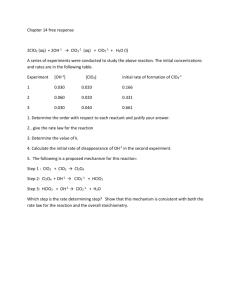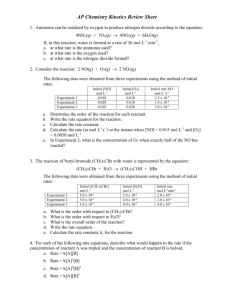Problems
advertisement

CHM 3410 – Problem Set 8
Due date: Wednesday, November 10th. (NOTE: The third hour exam is Friday, November 19 th).
Do the following problems. Show your work.
1) The rate of effusion Atkins, (pp 754-755) of a gas through a small hole into a vacuum is given by equn 20.16 of
Atkins.
- dN = pA0NA
dt
(2MRT)1/2
(1.1)
a) Starting with the above equation, derive the following equation, which applies for cases where the
pressure is constant (such as in the Knudsen method for determining the vapor pressure of a solid).
p = (2RT/M)1/2 (m/A0t)
(1.2)
b) The Knudsen method has been used to measure vapor pressures of metals at elevated temperature. In a
particular experiment, a sample of beryllium (Be) metal was placed in a cell at a temperature T = 1457 K. The
cross-sectional area of the effusion hole in the cell was A0 = 7.95 mm2. After operating for 60.2 minutes the mass of
beryllium lost through effusion was m = 9.54 mg. Based on this information find p, the vapor pressure of
beryllium, at this temperature.
2) Just as we defined the half-life for a chemical reaction, we can define other lifetimes. In particular, we may define
the “tenth life”, t1/10, as the time it takes for the concentration to decrease to 10% of its initial value.
Find an expression for t1/10 for a first order homogeneous and second order homogeneous irreversible
reaction.
3) The general differential equation for a nth order homogeneous irreversible reaction has the form
d[A]/dt = - k [A]n
(3.1)
a) Using the method discussed in class, find a general expression for [A] t for a system obeying equn 2.3.
Note that you should exclude the case n = 1 in finding your general solution.
b) Using your general solution from part a, find [A] t for the case n = 2 and n = 3. For n = 2, compare your
result to the one obtained in class.
c) Derive the following general expresion for t1/2, the half-life, for an nth order homogeneous reaction.
t1/2 =
2n-1 – 1
(n-1) k [A]0n-1
(3.2)
d) Using the general expression for t1/2 (equn 3.2) find t1/2 for the case n = 2 and n = 3. For n = 2, compare
your result to the one obtained in class.
e) Consider a series of experiments where the half-life for an nth order homogeneous reaction is measured
for several initial concentrations of A. Based on equn 3.2, find a way of plotting the data that will allow you to
determine n, the order of the reaction. Does your method also work for the case n = 1? (This method is called the
method of half-lives, and is occasionally used to find reaction orders from experimental data).
4) The following experimental data were obtained for a particular irreversible reaction. It is assumed that the
reaction obeys a rate law of the form
rate = - d[A]/dt = k [A]p [B]q
(4.1)
Trial
[A]initial
(mol/L)
[B]initial
(mol/L)
(Rate)initial
(mol/L.min)
1
2
3
4
0.00100
0.00100
0.00100
0.00100
0.00100
0.00200
0.00400
0.01000
2.6 x 10-8
1.2 x 10-7
3.9 x 10-7
2.4 x 10-6
5
6
7
0.00200
0.00400
0.01000
0.00200
0.00200
0.00200
1.5 x 10-7
1.1 x 10-7
1.6 x 10-7
Based on the above data find p, q, and k (including correct units).
5) Consider a chemical reaction that can form two different sets of products
(1) A + B C + D
- d[A]/dt = k1 [A] [B]
(2) A + B E + F
- d[A]/dt = k2 [A]
Notice that reaction (1) is second order heterogeneous, while reaction (2) is first order homogeneous.
It is difficult (but possible) to find a general expression for [A]t for the above system. However, under
pseudo-first order conditions ([B]0 >> [A]0) an approximate rate law can easily be found.
a) Find an expression for [A]t for pseudo-first order conditions for the above reaction.
b) In a series of experiments the initial concentration of A and the concentration of A after 30.0 minutes
were measured. Based on these data, find k1 and k2 (including correct units). Note that all concentrations below are
in units of mol/L.
[A]0
[A]t=30 min
[B]0
0.00140
0.00140
0.00140
0.00104
0.00091
0.00079
0.100
0.200
0.300
Problems
21.2
The data below apply to the reaction (CH3)3CBr + H2O (CH3)3COH + HBr. Determine the
order of the reaction, the rate constant, and the molar concentration of (CH3)3CBr after 43.8 hours. (Note: Time is in
units of hours, and concentration is in units of mol/L).
time
[(CH3)3CBr]
2.07 x 10-2
0.00
10.39 x 10-2
3.15
8.96 x 10-2
6.20
10.00
7.76 x 10-2
18.30
6.39 x 10-2
3.53
30.80
x
10-2
Solutions.
1)
a) We begin with the equation
- dN = pA0NA
dt
(2MRT)1/2
If we solve for pressure, we get
p = (2MRT)1/2 (- dN/dt)
A0NA
But dN/NA = dn, the change in the number of moles of substance. Also, since pressure is constant, it follows that
dn = n
dt
t
If we call n the change in the number of moles of substance (to get rid of the negative sign), then
p = (2MRT)1/2 n
A0
t
If we multiply and divide by M, and recall that Mn = m, then
p = (2MRT)1/2 n M = (2RT/M)1/2 m
A0
t M
A0t
b) For the conditions in the problem (and noting that M(Be) = 9.01 x 10-3 kg/mol, t = 60.2 min = 3612. s)
p = [2(8.3145 J/mol.K)(1457. K)/(9.01 x 10-3 kg/mol) ]1/2
(9.54 x 10-6 kg)
(7.95 x 10-6 m2) (3612. s)
= 0.97 N/m2 = 7.2 mtorr
2)
For a first order homogeneous reaction
[A]t = [A]0 exp(-kt)
At t = t1/10, [A]t = [A]0/10, so
[A]0/10 = [A]0 exp(-kt1/10)
1/10 = exp(-kt1/10)
Taking the inverse ln of both sides gives
ln(1/10) = - ln(10) = - kt1/10
t1/10 = ln(10)/k
For a second order homogeneous reaction
(1/[A]t) = (1/[A]0) + kt
At t = t1/10, [A]t = [A]0/10, so
(10/[A]0) = (1/[A]0) + kt1/10
(10/[A]0) – (1/[A]0) = (9/[A]0) = kt1/10
t1/10 = 9/([A]0k)
n1
3)
a) d[A] = - k [A]n
dt
So
d[A] = [A]-n d[A] = - k dt
[A]n
If we integrate both sides of this equation from t = 0 to t = t, we get
[A]-n+1 |0t = - k t |0t
(-n + 1)
[A]t1-n - [A]01-n = - kt
(1 - n)
[A]t1-n = (n - 1) kt + [A]01-n
[A]t = { (n - 1) kt + [A]01-n }1/1-n
b) When n = 2 (second order homogeneous rate law)
[A]t = { kt + [A]0-1 ]-1 =
[A]0
( 1 + kt[A]0 )
as expected.
When n = 3 (third order homogeneous rate law)
[A]t = { 2kt + [A]0-2 }-1/2 = [ (2kt[A]02 + 1)/[A]02 ]-1/2 = [ [A]02/(2kt[A]02 + 1 ]1/2
c) It is easiest to find an expression for t1/2 by using one of the intermediate equations above
[A]t1-n - [A]01-n = - kt
(1 - n)
But when t = t1/2 [A]t = [A]0/2. Substituting above gives
( [A]0/2)1-n - [A]01-n = - kt1/2
(1 - n)
t1/2 = [A]01-n - ([A]0/2)1-n
(1 - n) k
While the above is a perfectly good final result, we can obtain a prettier and more useful equation if we multiply the
numerator and denominator by 21-n, to get
t1/2 = 21-n [A]01-n - [A]01-n = ( 21-n - 1) [A]01-n
21-n (1 - n) k
21-n (1 - n) k
d) For n = 2
t1/2 =
(2 – 1)
k[A]0
= 1/(k[A]0)
=
(21-n - 1)
= (1 - 2n-1)
= (2n-1 – 1)
n-1
n-1
2 (1-n) k [A]0
(1 - n) k [A]0
(n-1)k[A]0n-1
1-n
For n = 3
t1/2 = (4 – 1) = 3/(2k[A]02)
2k[A]02
e) If we take the ln of our equation for t1/2, we get
ln(t1/2) = ln [ (21-n - 1)/21-n (1 - n) k ] + (1 - n) ln[A]0
Note what this rells us. If we plot ln(t1/2) vs ln[A]0 we will get a line whose slope is equal to (1 - n), which allows us
to determine the order of the reaction. This is the basis for the method of half-lives for finding the reaction order for
a reaction that is nth order homogeneous. The method is actually a bit more useful that it sounds, because we can use
the same trick discussed in class for pseudo-first order kinetics (making the reactant whose order of reaction is to be
determined much lower in concentration than other reactants) to determine the reaction orders for each reactant.
4) To find p, we plot ln k vs ln[A]0 for trials 2, 5, 6, and 7 (where [B]0 is constant)
trial
ln[A]0
ln k
2
5
6
7
- 6.908
- 6.215
- 5.521
- 4.605
- 15.94
- 15.71
- 16.02
- 15.65
The data are plotted below
Plot of ln k vs ln[A]0
-15.6
-7
-6
-5
-4
-15.7
ln k
-15.8
-15.9
-16
-16.1
ln[A]0
The best fit to the data gives ln k = 0.081 ln[A]0 – 15.36
So p = 0.081, or, rounded off to the nearest reasonable value, p = 0.
To find q, we plot ln k vs ln[B]0 for trials 1, 2, 3, and 4 (where [A]0 is constant)
trial
ln[B]0
ln k
1
2
3
4
- 6.908
- 6.215
- 5.521
- 4.605
- 17.47
- 15.94
- 14.76
- 12.94
The data are plotted below
Plot of ln k vs ln[B]0
-12
-7
-6
-5
-4
ln[B]0
-14
-16
-18
ln k
The best fit to the data gives ln k = 1.942 ln[B]0 – 3.99
So q = 1.942, or, rounded off to the nearest reasonable value, q = 2.
The rate law therefore is Rate = k [B]2 . From the initial rate data, we may find k using
k = (Rate)i/[B]02
trial
k (L/mol.min)
1
2
3
4
5
6
7
0.0260
0.0300
0.0244
0.0240
0.0375
0.0275
0.0400
AVE
k = 0.030 L/mol.min
5)
a) Since both processes occur simultaneously, the total rate of change of A with respect to time is
- d[A]/dt = (k1[B] + k2) [A]
Normally this would be a difficult equation to solve, but since [B] 0 >> [A]0, we may assume [B] = [B]0 = constant
If we define k = k1[B]0 + k2, then
- d[A]/dt = k[A]
This is just the expression for first order homogeneous kinetics, and so
[A]t = [A]0 exp(-kt)
b) We first need a way to find k from the experimental data.
[A]t/[A]0 = exp(-kt). Taking the ln of both sides gives
ln{[A]t/[A]0} = - kt
k = (-1/t) ln{[A]t/[A]0} = (1/t) ln{[A]0/[A]t}
Once we have values for k, then since k = k1[B]0 + k2, a plot of k vs [B] will have a slope equal to k1 and
an intercept equal to k2.
[B]0
k (min-1)
0.100
0.200
0.300
0.00991
0.01436
0.01907
The data are plotted below
Plot of k' vs [B]0
0.02
k'
0.015
0.01
0.005
0
0
0.05
0.1
0.15
0.2
[B]0
0.25
0.3
0.35
Based on the plot I get k = (0.0458 L/mol.min) [B]0 + 0.0053 min-1 , and so
k1 = 0.0458 L/mol.min
k2 = 0.0053 min-1
Problem 21.2
The easiest way to determine the order of the reaction is to plot ln[CH 3)3CBr] vs time (to check if 1st order)
and 1/[ CH3)3CBr] vs time (to check if 2nd order.
time (hr)
ln[CH3)3CBr]
1/[ CH3)3CBr] (L/mol)
0.00
3.15
6.20
10.00
18.30
30.80
- 2.264
- 2.412
- 2.556
- 2.750
- 3.344
- 3.878
9.625
11.161
12.887
15.649
28.329
48.309
The data plots are plotted below. The plot of ln[CH3)3CBr] vs time looks like it gives a better fit to a line than the
plot of 1/[CH3)3CBr] vs time, suggesting the reaction is first order. The best fit line is
ln[CH3)3CBr] = ( - 0.0542) hr-1 t – 2.248
and so k = 0.0542 hr-1.
At t = 43.8 hr, [A] = (10.39 x 10 -2 mol/L) exp[ - (0.0542 hr-1) (43.8 hr) ] = 0.97 x 10 -2 mol/L
Plot of ln[M] vs t
-2
0
5
10
15
20
ln[M]
-2.5
-3
-3.5
-4
t(hour)
25
30
35
Plot of 1/[M] vs t
60
1/[M] (L/mol)
50
40
30
20
10
0
0
5
10
15
20
t(hour)
25
30
35
![Some Examples of Experimental Rate Laws Rate = k[A]](http://s3.studylib.net/store/data/008429765_1-55c81f2e6368c61bd42b7e157f3d34f1-300x300.png)







